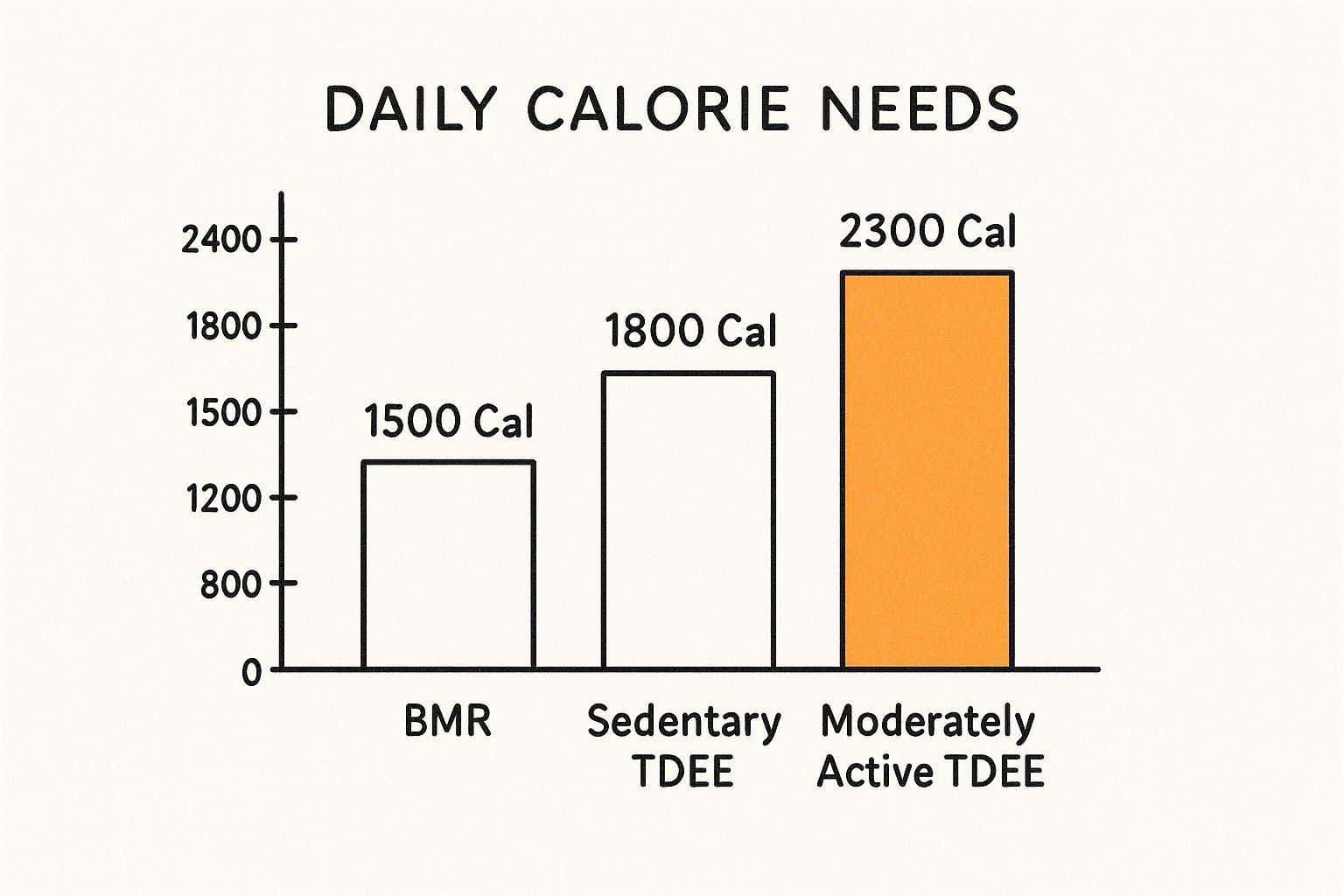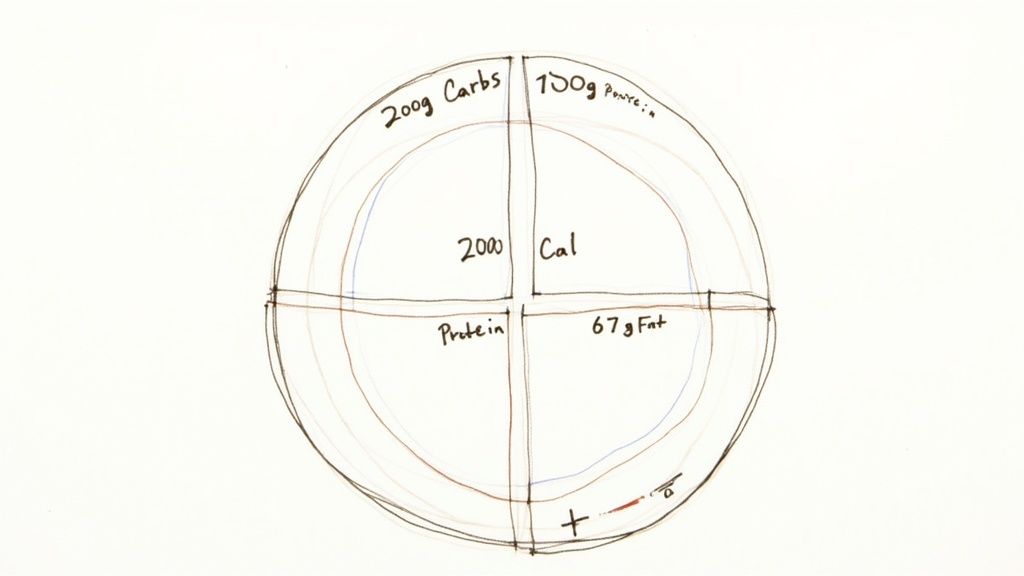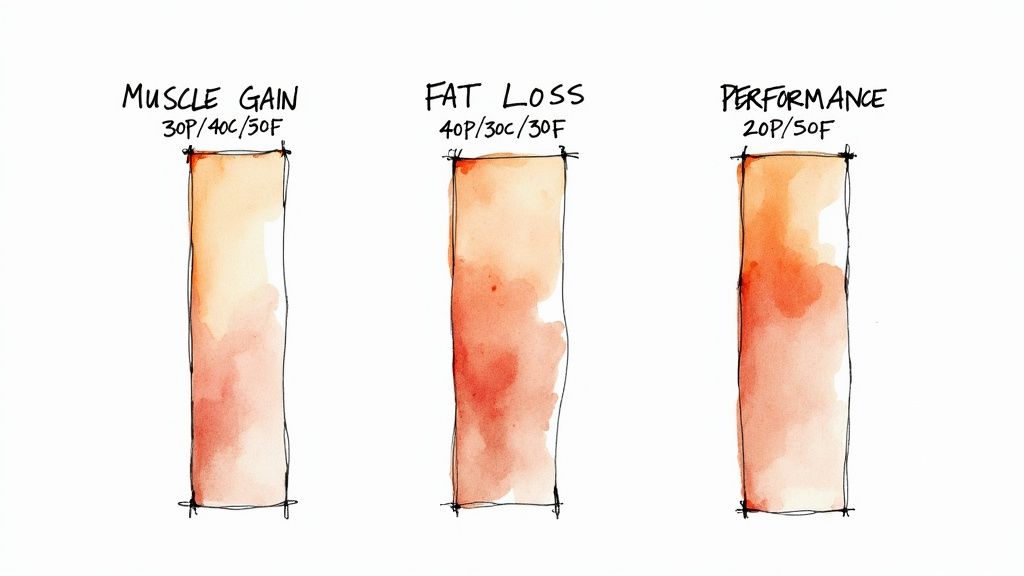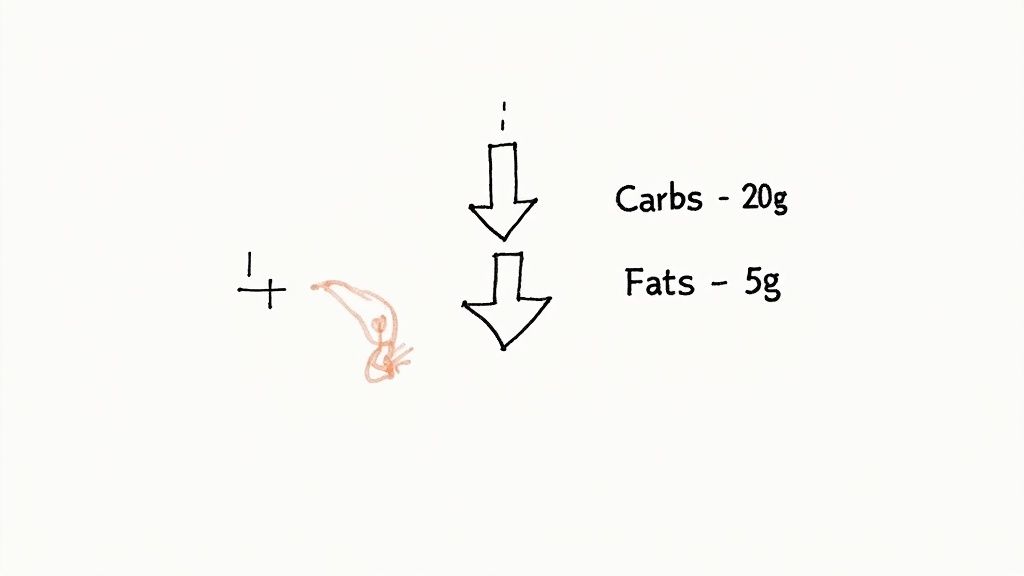Learn how to calculate macros with our no-nonsense guide. We break down TDEE, goal-specific ratios, and tracking to help you get consistent results.
This article is proposed by Gymkee, the personal trainer software that allows you to deliver the best coaching experience to your clients while saving time and growing your personal training business.
Try Gymkee for free for 14 daysCalculating your macros starts with one number: your daily calorie target. This is your Total Daily Energy Expenditure (TDEE)—the total calories you burn each day. To find it, we first calculate your Basal Metabolic Rate (BMR) and then factor in your activity level.
Before touching macros, you need your total energy budget. Calculating macros without a calorie goal is pointless. Your TDEE is a dynamic baseline that accounts for your resting metabolism and all daily movement.
The most practical formula is the Mifflin-St Jeor equation. It's widely used to estimate your Basal Metabolic Rate (BMR), the calories your body needs to perform basic functions like breathing and circulation.
The Mifflin-St Jeor equation is considered more accurate than older formulas. It uses your weight, height, age, and sex.
This number is what your body needs in a state of complete rest. Now, let's adjust for real-world activity.
Multiply your BMR by an activity factor to find your TDEE (your maintenance calories). Be honest here; overestimating activity is a common mistake that derails results.
Practical Tip: If you have a desk job but work out 3-4 times a week, you're likely "Moderately Active," not "Very Active." Activity outside the gym—walking, chores, daily errands—counts.
This bar graph shows how daily calorie needs increase from a baseline BMR to different activity levels.

Moving from a sedentary to a moderately active lifestyle can increase your daily calorie needs by over 500 calories. This final TDEE figure is the essential starting point for all macro calculations.

You have your TDEE. Now, we break that calorie budget into protein, carbohydrates, and fats. This turns a number into a daily nutrition strategy.
The math is based on the energy each macronutrient provides.
The energy values used today, known as the Atwater System, were established in the late 1890s. This research determined that protein and carbohydrates provide approximately 4 calories per gram, while fat provides 9 calories per gram. This 4-4-9 rule is the foundation of modern nutrition calculations.
These three numbers are all you need to convert your calorie goal into gram targets you can track.
First, decide on a percentage split. There is no "perfect" ratio, but a balanced starting point for general fitness is 40% carbs, 30% protein, and 30% fat.
Let's use a 2,000-calorie daily target as an example.
Calculate the calories from each macro based on your chosen percentages.
Now, convert those calorie figures into grams.
Apply the 4-4-9 rule to get the tangible numbers you'll aim for each day.
A 2,000-calorie goal with a 40/30/30 split translates to a daily target of 200g carbs, 150g protein, and 67g fat.
The table below shows how gram targets change with different splits, even at the same total calories.
| Calorie to Gram Conversion Examples (2000 Calorie Diet) |
| :--- | :--- | :--- | :--- |
| Macro Split (P/C/F) | Protein (Grams) | Carbs (Grams) | Fat (Grams) |
| 30/40/30 | 150g | 200g | 67g |
| 30/50/20 | 150g | 250g | 44g |
| 40/40/20 | 200g | 200g | 44g |
| 25/55/20 | 125g | 275g | 44g |
You can apply this same process to any calorie target or percentage split.
If you're managing these calculations for clients, our guide on using a dedicated nutrition builder tool can streamline the process.

You know the math. Now, which percentage split is right for you? There is no single magic ratio. The ideal split depends entirely on your goal, whether that's muscle gain, fat loss, or athletic performance.
Your macros are how you spend your calorie budget to get the desired result.
For building lean mass, protein is non-negotiable. Resistance training creates micro-tears in muscle fibers; protein provides the amino acids to repair them, making them bigger and stronger.
A higher protein intake is a requirement for maximizing muscle growth. Research consistently shows a range of 1.6 to 2.2 grams of protein per kilogram of body weight (0.7 to 1.0 g/lb) is optimal for muscle protein synthesis.
For a deeper dive, check this guide on how to build muscle mass.
A solid macro split for a muscle-gain phase is:
Carbohydrates are also critical for refilling muscle glycogen stores depleted during workouts, which supports an anabolic (muscle-building) state.
For fat loss, you'll be in a calorie deficit, and protein becomes even more critical. A high-protein diet helps preserve muscle mass while you lose fat, which is essential for maintaining your metabolic rate.
Protein also has the highest thermic effect of food (TEF), meaning your body burns more calories digesting it compared to carbs and fats. It's also highly satiating, helping you feel fuller on fewer calories.
Pro Tip: A smart approach for fat loss is to anchor your diet with protein and fiber-rich carbs. This combination is a powerhouse for satiety, making it far easier to stick to your calorie deficit without feeling hungry all the time.
A balanced macro split for fat loss could look like this:
Remember, this is a starting point. Effective programming often involves tweaking these numbers based on progress and biofeedback.
If you're unsure where to begin, the Acceptable Macronutrient Distribution Range (AMDR) from the National Academies provides a safe, evidence-based framework.
The AMDRs for adults are:
These ranges are designed to ensure adequate nutrient intake and reduce chronic disease risk. Think of it as a scientifically-backed foundation to build from.

You've calculated your starting macros. The common mistake is treating these numbers as permanent. Your body adapts; as you lose weight or get fitter, your energy needs change. What worked in week one won't necessarily work in week six.
Think of your macros as a dynamic roadmap, not a fixed destination. Adjustments are required to keep making progress.
How do you know when to adjust? Look for consistent patterns, not daily fluctuations. A true plateau is a trend over time.
It might be time for a tweak if you notice:
Rule Out Other Factors First: Before cutting calories, check your fundamentals. Are you sleeping enough? Is stress high? Are you tracking food accurately? These factors can halt progress just as effectively as the wrong macros.
When it's time for a change, be strategic. Drastic calorie cuts can harm your metabolism and make long-term progress harder. Make small, calculated tweaks.
For a fat loss plateau, reduce daily calories by about 100-150. This can be achieved by:
Keep protein high to preserve muscle and pull calories from either carbs or fats. Make one change, then hold the new numbers for another two to three weeks to assess your body's response before considering another adjustment.
After a long fat loss phase, jumping back to old eating habits is a recipe for rapid weight regain. This is where a reverse diet is crucial.
A reverse diet is the process of slowly and systematically increasing calorie intake over weeks or months. By making small, controlled additions (e.g., adding 5-10g of carbs or 1-2g of fat per week), you allow your metabolism to adapt and ramp up.
The goal is to establish a new, higher maintenance calorie level, allowing you to eat more food with greater flexibility while keeping the weight off.
Knowing your numbers is one thing; hitting them consistently is another. The goal isn't perfection, but a sustainable habit that provides useful data. Tracking apps like MyFitnessPal or Cronometer are the easiest way to start, largely due to their extensive food databases and barcode scanners.
To make tracking efficient, use the app's features. Create custom meals and recipes for foods you eat regularly. If you have the same protein smoothie every morning, save it as a single entry instead of logging five separate ingredients daily.
To be truly proficient, you must know how to effectively read food labels. This is the core skill that allows you to verify app data and make smart choices.
Key Takeaway: Imperfect tracking is infinitely better than no tracking. Even a partial log provides useful data. Don't let one untracked meal derail your entire day or week.
For coaches, managing multiple clients with spreadsheets is inefficient. Using a platform with simplified client tracking centralizes data, making it easier to monitor progress and provide timely feedback.
You won't always have a food scale. Learning to estimate is a necessary skill.
The quality of your tracking depends on the data. In the United States, the Nutrition Labeling and Education Act of 1990 standardized food labels, making the information you find generally reliable.
Here are direct answers to common questions that arise once you start tracking.
No. Consistency beats perfection. Your weekly average matters far more than hitting your numbers perfectly every single day.
Focus on two priorities: total calories and protein. These have the biggest impact on body composition and satiety. If your carbs and fats fluctuate by 5-10 grams daily, it won't derail your progress.
Don't let one "off" day become an "off" week. If you go over your targets, acknowledge it and get back on track with your next meal.
Alcohol contains 7 calories per gram but isn't a macronutrient. You must account for its calories by "borrowing" them from your carb or fat allowance. Protein is too important for muscle preservation to sacrifice.
For a standard drink with 14g of alcohol (98 calories):
Pick one method, log it in your app, and subtract that amount from your daily target for the chosen macro.
The process for calculating your TDEE is identical. However, the macronutrient ratios for a ketogenic diet are drastically different, designed to induce ketosis where the body uses fat for fuel instead of glucose.
A typical keto split is:
You would start with your TDEE, then apply this fat-dominant ratio instead of a more balanced one.
Tracking apps are tools, and their accuracy depends on the data entered. User-generated entries are often incorrect.
For best results:
At Gymkee, we know that managing nutrition for yourself or for clients requires tools that are both powerful and easy to use. Our platform integrates nutrition and workout programming seamlessly, so you can build meal plans, set macro goals, and track progress all in one place. Stop juggling spreadsheets and start coaching more effectively by visiting us at https://www.gymkee.io.
This article is proposed by Gymkee, the personal trainer software that allows you to deliver the best coaching experience to your clients while saving time and growing your personal training business.
Try Gymkee free for 14 days